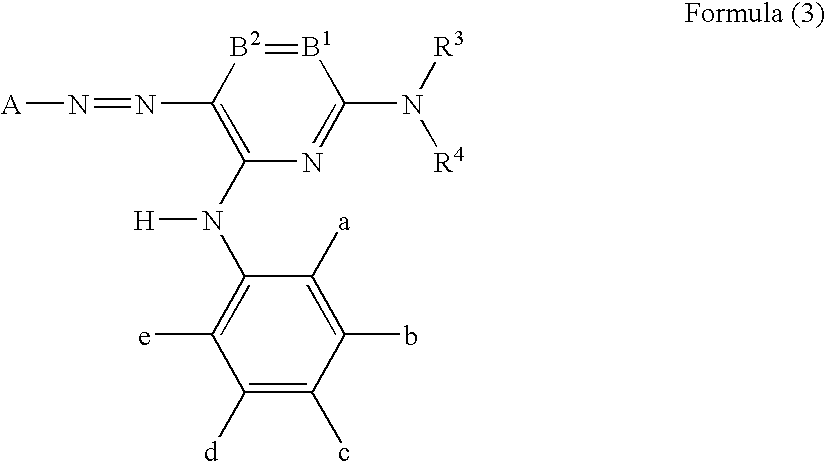Coloring composition and inkjet recording ink composition
a technology of inkjet recording and composition, applied in the field of color composition, can solve the problems of reducing print quality, characters or the like cannot be printed with desired accuracy, and it is extremely difficult to obtain coloring matters capable of satisfying these requirements without reducing their levels, so as to improve the storage stability of images and improve the stability of images
- Summary
- Abstract
- Description
- Claims
- Application Information
AI Technical Summary
Benefits of technology
Problems solved by technology
Method used
Image
Examples
example 1
(1) Synthesis Process of Intermediates (d-1) and (d-2)
[0166] They were synthesized in accordance with the process as described in JP-A-2002-371214.
(2) Synthesis Process of Intermediate (d-3)
[0167] To a suspension obtained by adding 1700 mL of acetonitrile and 3.5 mL of dimethylformamide to 83.7 g (70 mmol) of Intermediate (d-2) was added 62 mL (840 mmol) of thionyl chloride at room temperature. After the reaction mixture was heated under reflux for 3 hours, 850 mL of acetonitrile was distilled off by concentration under reduced pressure. The residue was poured into 2500 g of ice water and crystals thus precipitated were collected by filtration. They were washed with water and then dried, whereby 79.5 g (63.5 mmol, yield: 91%) of Intermediate (d-3) was obtained.
(3) Synthesis Process of Intermediate (d-4)
[0168] After 100 mL of dimethylacetamide was added to 12.3 g (80 mmol) of β-alanine ethyl ester hydrochloride to dissolve the latter in the former under heating, the resulting...
example 2
(Preparation of Aqueous Ink)
[0171] After the below-described components were stirred for 1 hour while heating at from 30 to 40° C., the reaction mixture was filtered under pressure through a micro filter having an average pore size of 0.2 μm and a diameter of 47 mm to prepare Ink solution A.
[0172]—Composition of Ink Solution A—
Dye compound (a-1)3.5parts by massDiethylene glycol2parts by massTetraethylene glycol monobutyl ether10parts by massGlycerin10parts by mass1,2-Hexanediol1part by mass2-Pyrrolidone1part by massUrea2parts by massWater70.5parts by mass
[0173] In a similar manner to that employed for the preparation of Ink solution A except that the dye compound was changed as described below in Table 2, Ink solutions B to F were prepared.
(Image Recording and Evaluation)
[0174] An image was recorded on “Kassai Shashin Shiage Advance” (inkjet paper; product of Fuji Photo Film) by each of Ink solutions A to F and Inkjet printer (“PM-A700”, trade name; product of Seiko Epson).
[0...
example 3
[0183] Each ink prepared in Example 2 was filled in a cartridge of Inkjet printer “BJ-F850” (trade name; product of CANON) and an image was printed on “Super Photo Paper SP-101” (trade name; product of CANON) by the printer. The image was evaluated in a similar manner to that in Example 2, whereby similar results to Example 2 were obtained.
[0184] From the coloring composition of the invention, a colored image and a coloring material, especially an inkjet recording ink, excellent in hue and fastness against light and active gases, especially an ozone gas, in the environment can be obtained.
[0185] The coloring composition of the invention can be used as a coloring composition for an ink sheet in a thermal transfer image forming material, electrophotographic toner, color filter for displays such as LCD and PDP or imaging device such as CCD, or various coloring compositions such as dyeing solutions for dyeing various fibers.
[0186] The novel dye compound of the invention to be used fo...
PUM
| Property | Measurement | Unit |
|---|---|---|
| mass % | aaaaa | aaaaa |
| mass % | aaaaa | aaaaa |
| pH | aaaaa | aaaaa |
Abstract
Description
Claims
Application Information
 Login to View More
Login to View More - R&D
- Intellectual Property
- Life Sciences
- Materials
- Tech Scout
- Unparalleled Data Quality
- Higher Quality Content
- 60% Fewer Hallucinations
Browse by: Latest US Patents, China's latest patents, Technical Efficacy Thesaurus, Application Domain, Technology Topic, Popular Technical Reports.
© 2025 PatSnap. All rights reserved.Legal|Privacy policy|Modern Slavery Act Transparency Statement|Sitemap|About US| Contact US: help@patsnap.com



